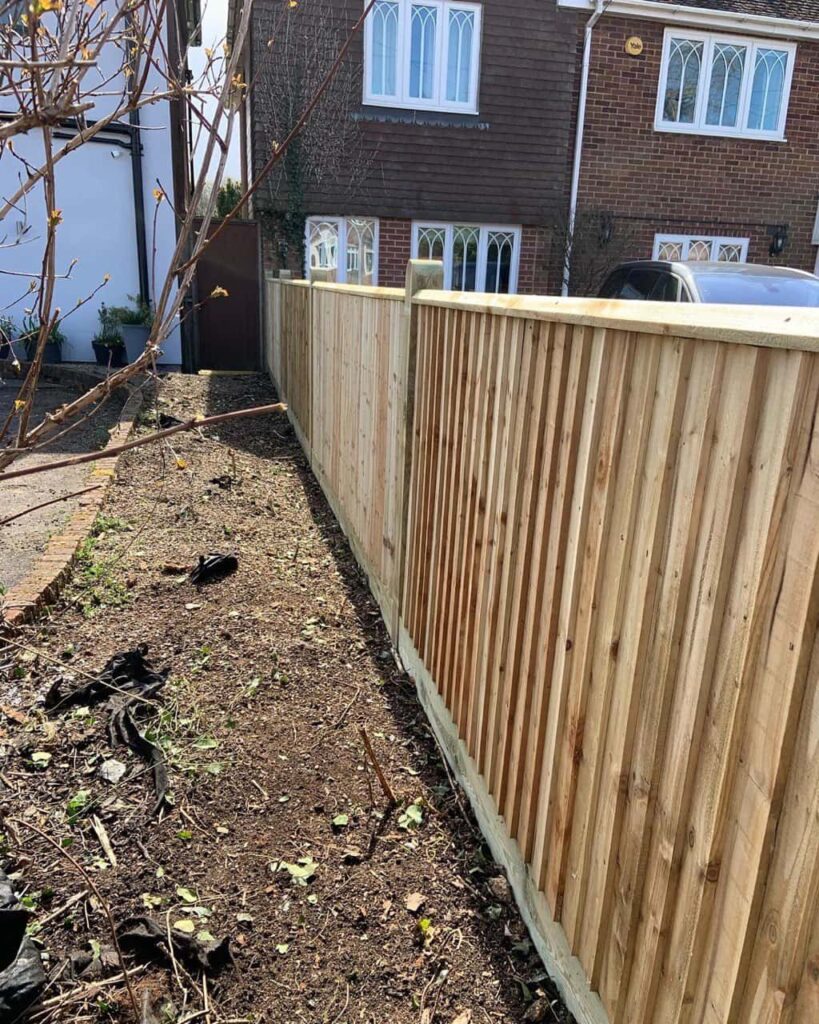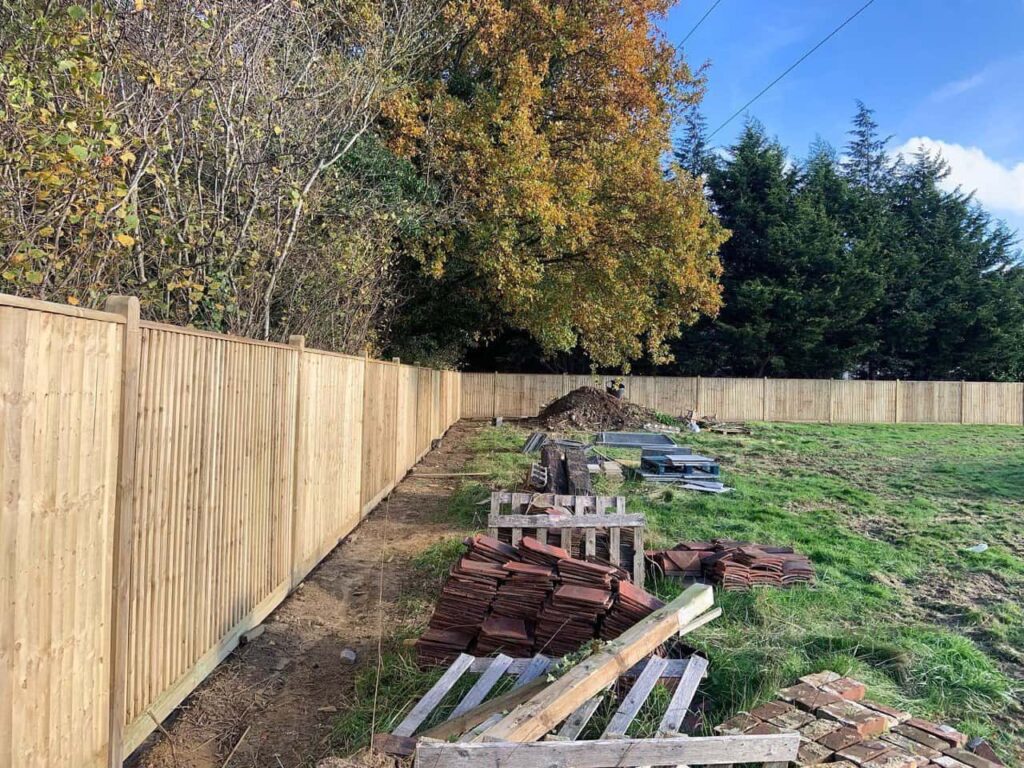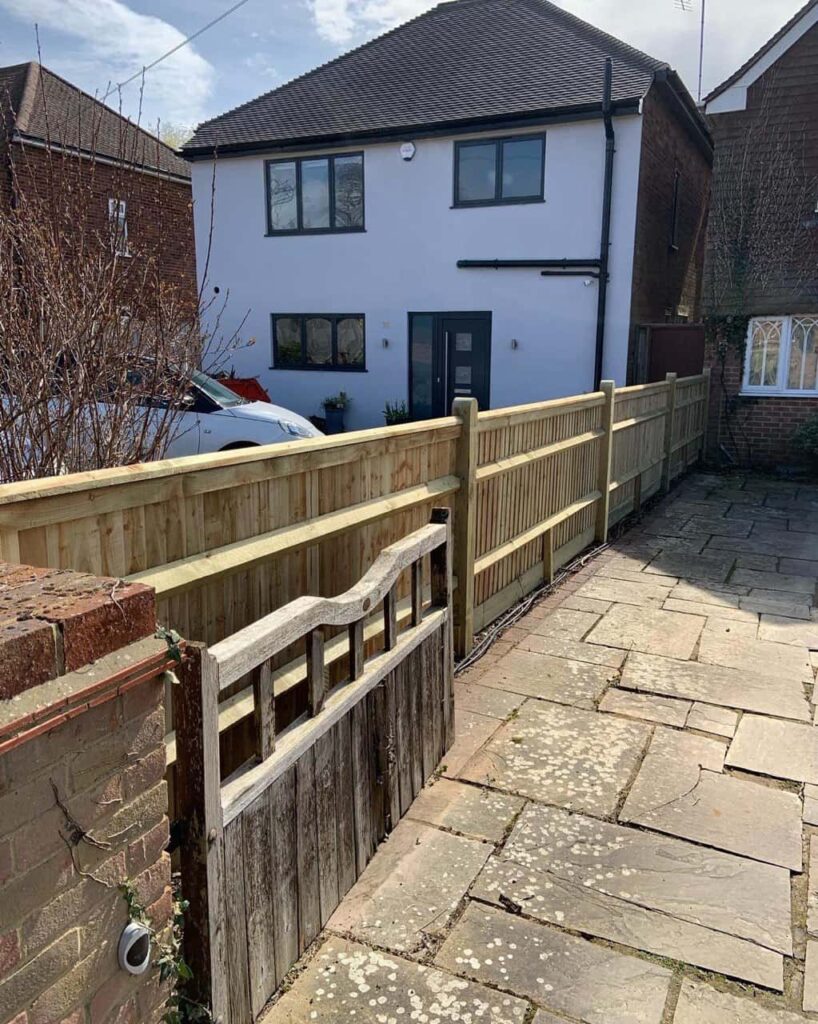FEATHER EDGE FENCING
What is Close Board Fencing?
Feather edge fencing, also known as close board fencing, is commonly used for boundaries, privacy, and security purposes. It is characterised by overlapping vertical boards that are nailed or screwed to horizontal rails, creating a sturdy and robust structure.
The boards used in feather edge fencing are typically tapered, meaning they are thicker at one end and thinner at the other, resembling the shape of a feather. This design allows the boards to overlap, providing strength, rigidity, and privacy.
Feather edge fencing is often constructed using pressure-treated timber, which enhances its durability and resistance to rot, decay, and insect damage. The vertical boards are usually installed on arris rails, which are horizontal rails with bevelled edges to facilitate water runoff.
One of the key advantages of feather edge fencing is its versatility. It can be installed on both level and sloping ground, making it suitable for various terrains. The overlapping boards provide a solid barrier that offers privacy, restricts visibility from the outside, and can withstand strong winds.
Feather edge fencing is commonly used in residential properties, commercial areas, farms, and public spaces. Its robust construction and aesthetic appeal make it popular for securing boundaries and creating attractive fencing solutions.
How does feather edge fencing differ from other types of fencing?
Feather edge fencing differs from other types of fencing in several ways. Here are some key points of differentiation:
Construction: Feather edge fencing consists of overlapping vertical boards secured to horizontal rails, creating a solid, sturdy fence. In contrast, other types of fencing, such as panel fencing or chain-link fencing, use pre-built panels or mesh materials.
Privacy: Feather edge fencing is designed to provide excellent privacy. The overlapping boards create a solid barrier that restricts visibility from the outside. In contrast, some other fencing options, like picket fences or post-and-rail fences, may offer less privacy due to their open or spaced design.
Strength and Durability: Feather edge fencing is known for its strength and durability. The overlapping boards and robust construction make it suitable for withstanding harsh weather conditions and resisting impacts. Other fencing types, such as wire fencing or plastic fences, may not offer the same level of strength and durability.
Customisation: Feather edge fencing can be customised to various heights, allowing you to choose the level of privacy and security that suits your needs. Other fencing options may have fixed panel sizes or limited height variations.
It’s important to consider these differences when choosing the right fencing option for your specific needs, taking into account factors such as privacy requirements, desired aesthetics, durability, and the terrain of your property.

Does feather edge fencing provide privacy and security?
Yes, feather-edge fencing provides both privacy and security. Here’s how:
Privacy: Feather edge fencing is designed to offer excellent privacy. The overlapping vertical boards create a solid barrier that restricts visibility from the outside. This means that it’s difficult for people passing by or neighbours to see into your property, providing you with a sense of seclusion and privacy.
Solid Construction: Feather edge fencing is constructed with robust materials, such as pressure-treated timber, and features overlapping boards secured to horizontal rails. This construction provides a sturdy and solid fence that adds more privacy than more open fencing styles, such as picket fences or chain-link fences.
Height Options: Feather edge fencing can be customised to different heights, allowing you to choose the level of privacy you desire. Taller fence panels can provide increased privacy by limiting the visibility from both ground level and neighbouring properties.
Boundary Definition: Feather edge fencing clearly defines the boundaries of your property. This helps deter unwanted trespassing and creates privacy by marking your space clearly.
Security: Feather edge fencing can enhance the security of your property. Its sturdy construction acts as a deterrent to potential intruders, making it more difficult for them to gain unauthorised access. The robustness of the fencing materials also makes it resistant to damage from external forces.
Reinforcement Options: Additional security features can be integrated into feather edge fencing installations. For example, you can install a gate with a secure lock system to control access points. Features like anti-climb spikes or security toppings can further enhance security.
While no fence can guarantee complete privacy or security, feather edge fencing offers a robust and reliable solution that provides a considerable level of privacy and helps improve the security of your property. It is a physical barrier that creates a sense of privacy and deters potential intruders, making it a popular choice for residential and commercial properties.
What are the advantages of feather edge fencing?
Feather edge fencing offers several advantages, making it a popular choice for many homeowners and property owners. Here are some of the key benefits of feather edge fencing:
Strength and Durability: Feather edge fencing is known for its robust construction. The overlapping vertical boards, secured to horizontal rails, create a solid, sturdy fence that can withstand harsh weather conditions and resist impacts.
Privacy and Security: The overlapping boards of feather edge fencing provide excellent privacy by restricting visibility from the outside. This makes it an ideal choice for creating secluded and secure spaces.
Versatility: Feather edge fencing can be installed on both level and sloping ground, making it suitable for various terrains. It can accommodate elevation changes and follow the land’s natural contours.
Customisable Height: Feather edge fencing can be constructed to different heights, allowing you to choose the level of privacy and security that suits your needs. It can be tailored to match specific requirements and preferences.
Aesthetic Appeal: Feather edge fencing offers a traditional, timeless appearance that complements various architectural styles. It’s clean lines and overlapping boards can enhance the overall look of your property.
Longevity: Feather edge fencing can have a long lifespan when constructed with pressure-treated timber. The treatment protects the wood from rot, decay, and insect damage, ensuring that the fence lasts many years with minimal maintenance.
Easy Maintenance: Feather edge fencing requires relatively low maintenance. Regular inspections, occasional cleaning, and repairs to damaged boards or rails are typically sufficient to keep the fence in good condition.
Cost-effective: Compared to other fencing options, feather edge fencing can be a cost-effective choice, especially considering its durability and long lifespan.
These advantages make feather edge fencing a popular and practical option for residential and commercial properties, offering a combination of strength, privacy, versatility, and aesthetic appeal.

Can feather edge fencing be installed on uneven terrain?
Yes, feather edge fencing can be installed on uneven terrain. One of the advantages of feather edge fencing is its adaptability to different landscapes, including sloping or uneven ground. Here’s how feather edge fencing can be installed on such terrain:
Planning: Start by assessing the terrain and determining the degree of slope or unevenness. This will help in planning the installation process and estimating the required materials.
Adjusting Post Heights: If the ground is uneven, you may need to adjust the heights of the fence posts to accommodate the slope. Taller posts can be used on the lower side of the slope, while shorter posts can be used on the higher side. This will ensure that the fence remains level along its top.
Step Installation: To follow the contours of a sloping terrain, the feather edge fence panels can be installed in a stepped pattern. This involves positioning the posts at different heights to create a stepped effect. The panels are then attached horizontally to the posts, following the slope of the ground.
Raking Panels: Another option is to use raking panels, also known as racked panels or stepped panels. These panels are specially designed to accommodate the slope of the ground. They have angled boards that follow the contour of the land, resulting in a fence that remains vertical and level.
Backfilling: Backfilling or using additional material may sometimes be necessary to level the ground beneath the fence posts. This helps provide stability and ensures the posts are firmly anchored.
By adjusting the post heights, using stepped installations, and employing specialised techniques, feather edge fencing can be successfully installed on uneven terrain, providing a level and secure fencing solution.

Can gates be integrated into feather edge fencing installations?
Yes, gates can be integrated into feather edge fencing installations. Adding a gate to your feather edge fence provides convenient access to your property while maintaining the security and aesthetics of the fencing. Here are a few key points to consider when integrating gates into your feather edge fencing:
Gate Type: Various types of gates can be integrated into feather edge fencing, including single gates, double gates, pedestrian gates, or driveway gates. The type of gate you choose depends on the intended purpose, the opening size, and your specific needs.
Matching Design: When selecting a gate, it’s recommended to choose one that matches the design and style of your feather edge fence. This ensures a cohesive and aesthetically pleasing look.
Gate Hardware: Consider the appropriate gate hardware for your specific gate installation. This includes hinges, latches, locks, and handles. Ensure the gate hardware is durable, weather-resistant, and securely attached to the gate and supporting posts.
Size and Clearance: Take accurate measurements to determine the size and clearance requirements for the gate. Consider factors such as the width of the opening, the space needed for the gate to swing open or slide, and any potential obstructions or uneven terrain that may affect gate operation.
Integrating gates into your feather edge fencing installation adds functionality, accessibility and enhances the overall security of your property. We can advise on ensuring proper and professional integration of gates into your feather edge fence.
How long does it take to install feather edge fencing?
The time it takes to install feather edge fencing can vary depending on several factors, including the size of the area, the complexity of the terrain, the number of installers, and the level of expertise. Here are some general considerations:
Preparation: Before installation, there may be some preparation work involved, such as clearing the area, removing any existing fencing, and levelling the ground. The time required for preparation depends on the condition of the site and the extent of the work needed.
Material Delivery: We’ll need to factor in the time it takes for the delivery to arrive. This can vary depending on the supplier and your location.
Terrain and Obstacles: The complexity of the landscape and the presence of obstacles can affect installation time. Uneven or sloping ground, rocky soil, or the need to work around trees, structures, or utilities may require additional time and effort.
Fence Length and Height: The overall length and height of the fence will influence the installation time. Installing a longer or taller fence naturally takes longer than a shorter or lower one.
As a rough estimate, installing feather edge fencing can take anywhere from a few days to a week or more for a standard-sized residential property, depending on the factors mentioned above. It’s advisable to consult with professionals or obtain quotes from contractors who can provide a more accurate assessment based on your specific project requirements.
Looking for feather edge fencing near me?
We can help. Here are just some of the areas we offer feather edge fencing installations and repairs:
